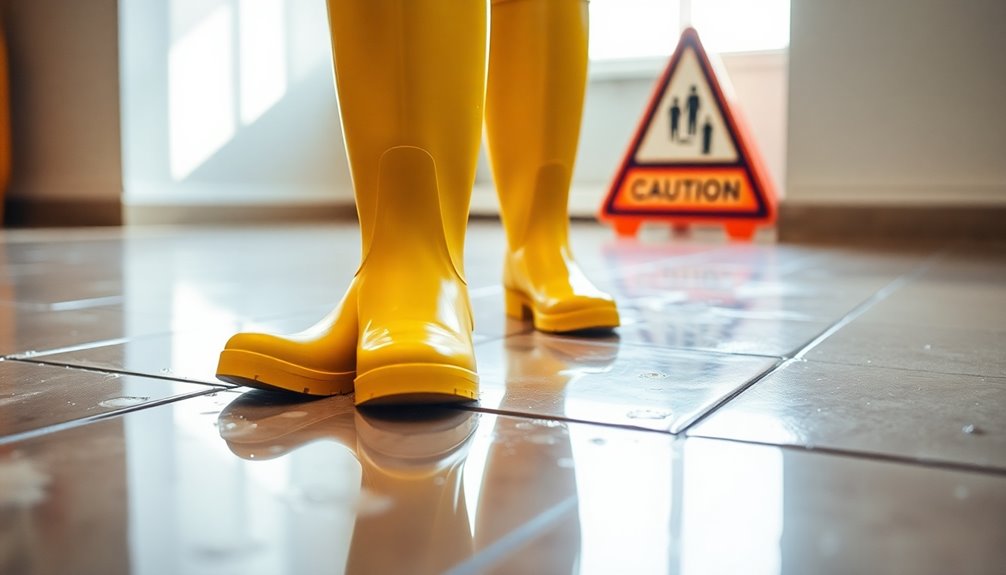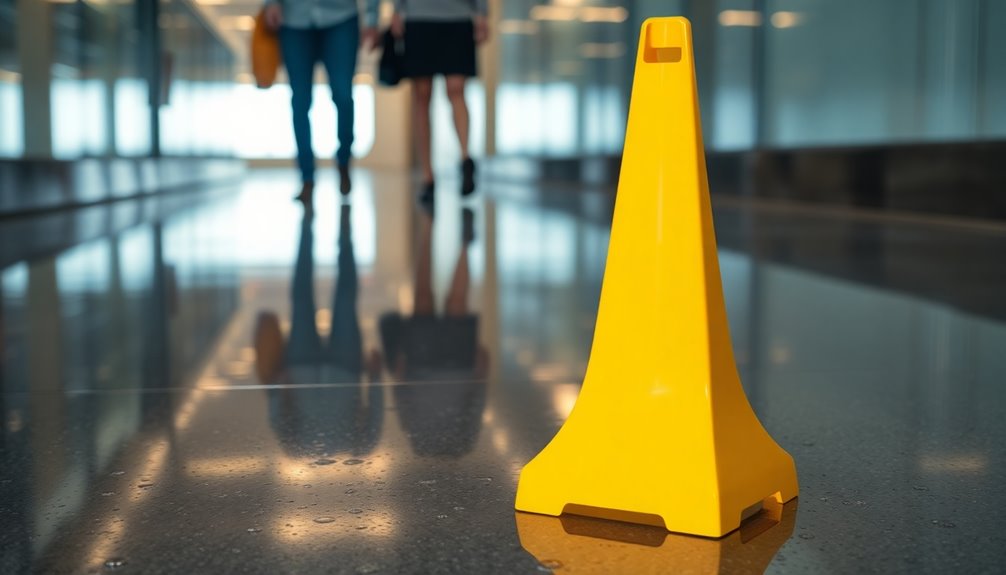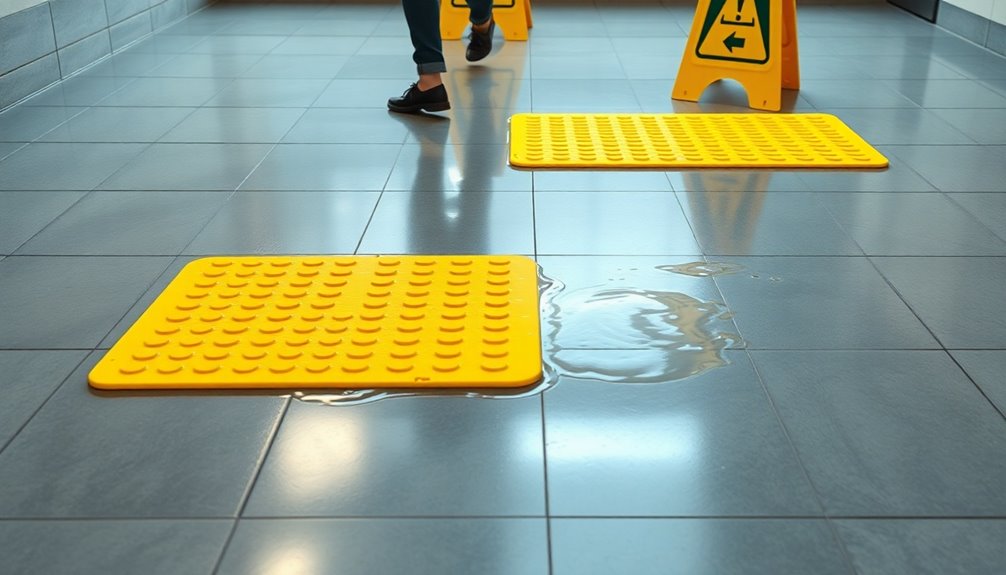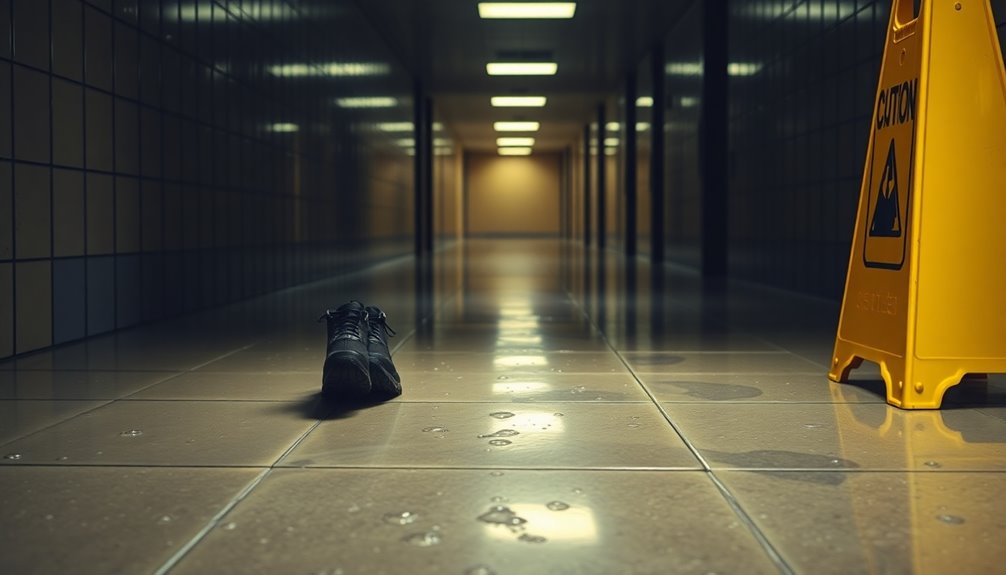You can walk on damp floors, but you need to be cautious. Slip and fall accidents are common on wet surfaces, so take safety seriously. Wear slip-resistant footwear to enhance your grip, and clean up spills immediately. Use caution signs to warn others, and maintain good lighting to improve visibility. Walk slowly with small steps and keep your feet slightly outward for better balance. By following these frugal safety tips, you can greatly reduce your risk of injury. There are even more strategies to guarantee your safety while traversing damp areas, which can help keep you on your feet.
Importance of Wet Area Safety
In environments where water and other liquids are present, the importance of wet area safety can't be overstated. Wet floors contribute considerably to slip and fall accidents, making vigilance essential. You need to recognize that implementing proper safety measures can cut these accidents by up to 50%. Additionally, effective categorization of safety protocols can enhance overall workplace safety.
Utilizing non-slip surfaces and placing clear warning signs are simple yet effective steps you can take to enhance safety. Timely payments to contractors for maintenance can also ensure that safety measures are consistently upheld. Additionally, investing in advanced safety technology can further enhance the effectiveness of your safety protocols.
Compliance with safety regulations is imperative, not just for your peace of mind, but to protect your business from legal liabilities. Being aware of the hazards associated with wet areas fosters a culture of safety among employees and customers alike. Regular inspections and maintenance play an important role in this. Make it a habit to promptly clean up spills and guarantee that wet floor warnings are visible.
Effective Cleaning Techniques
When you're cleaning, tackle small sections at a time to keep your workspace safe and manageable. It's smart to schedule your cleaning during low traffic times, so you minimize the risk of slips and falls. Additionally, consider using sustainable packaging solutions for your cleaning products to reduce your environmental impact while maintaining safety. Implementing a zero-based budgeting method can help you allocate funds effectively for cleaning supplies without overspending. Using user-friendly interfaces in expense tracking tools can streamline your budgeting process, making it easier to manage your cleaning expenses efficiently.
Clean in Small Sections
Cleaning in small sections is one of the smartest strategies to keep your space safe and hazard-free. By tackling damp floors in manageable areas, you minimize the risk of slipping and can quickly address any wet spots before they become hazardous.
Here are some tips to enhance your floor safety:
- Start from the farthest corner: Begin cleaning in the farthest wet area and work your way backward toward the exit. This way, you avoid walking over freshly cleaned surfaces.
- Avoid re-entering cleaned areas: Once you've cleaned a section, don't walk over it again. This prevents footprints and additional slip hazards that can increase drying time.
- Use caution signs: Make sure to place clear signage or barriers around the wet areas. This alerts others to the potential danger and helps maintain a safer environment.
- Schedule wisely: Ideally, plan your cleaning during periods of low traffic. This minimizes the likelihood of accidents and keeps pathways safe for a lot of people.
Schedule During Low Traffic
To guarantee a safe and effective cleaning process, scheduling tasks during low traffic periods is vital. Cleaning during early mornings or evenings minimizes the risk of slips and falls from damp floors. By avoiding peak hours, you reduce the likelihood of accidents, securing a safer environment for everyone.
When you clean, tackle small, manageable sections. This approach not only minimizes the area of wet surface exposure but also allows for quicker drying times, which is essential for safety.
Make certain to utilize caution signs to clearly block off cleaned areas, so individuals are aware of potential slip hazards while the floors dry.
Implementing a routine cleaning schedule that aligns with low activity times keeps your space safe and clean without disrupting workflow. By sticking to this plan, you create a consistent environment that prioritizes safety.
Anti-slip Tips for Safety

Slipping on damp floors can happen to anyone, but there are effective ways to protect yourself from falls. When maneuvering slippery surfaces, it's crucial to adopt a cautious approach. Here are some anti-slip tips to keep in mind:
- Slow Down: Increase your awareness by taking small, deliberate steps. This helps maintain your balance and stability on damp floors. Regularly using budget apps can also help you keep track of your financial health, which in turn reduces stress and enhances focus on safety.
- Foot Position: Walk with your feet slightly outward and make wide turns at corners to prevent losing your footing.
- Use Handrails: Whenever available, utilize handrails for added support. This can greatly reduce your risk of falls on slippery surfaces.
- Wear Slip-Resistant Footwear: Choose shoes designed for traction. Slip-resistant footwear enhances grip and can prevent accidents on wet floors. Utilizing automated bill payment notifications can also relieve financial stress, allowing you to focus on safety.
Lastly, stay vigilant of your surroundings. Avoid carrying bulky or obstructive items that could hinder your visibility while maneuvering damp areas. Additionally, consider implementing clear payment terms in your financial transactions to ensure timely payments and reduce stress related to unexpected costs.
Risk Reduction Strategies
When it comes to risk reduction, choosing the right footwear and adopting cautious walking techniques can make all the difference.
Opt for shoes with good traction to enhance your grip on slippery surfaces, and always be mindful of your surroundings. Additionally, maintaining a clear understanding of your financial situation can help you allocate resources for appropriate footwear that ensures safety on damp floors while managing your budget effectively, such as utilizing tools like expense tracking. Using an application like Zoho Expense can further streamline your financial management, allowing you to focus on your safety needs without overspending. Regularly tracking expenses can reveal areas to save money for essential safety items.
Effective Footwear Choices
Choosing the right footwear can make a notable difference in preventing slips and falls, especially on damp surfaces. When traversing wet environments, it's vital to prioritize safety by selecting shoes that enhance grip and stability.
Here are some effective footwear choices to keep in mind:
- Slip-Resistant Footwear: Look for shoes specifically designed with slip-resistant soles. They greatly enhance grip on damp surfaces.
- Rubber Soles: Opt for footwear with rubber sole materials, as they provide better traction compared to smoother soles.
- Good Ankle Support: Choose shoes that offer solid ankle support. This can help maintain your balance while walking on wet floors, reducing the chance of accidents.
- Tread Pattern: Select footwear with a tread pattern designed for wet conditions. This feature channels water away, improving contact with the floor.
Regularly inspecting and replacing worn-out footwear is important to guarantee peak performance and safety.
Cautionary Walking Techniques
Traversing damp floors requires careful walking techniques to enhance safety and reduce the risk of falls. First, slow down and take smaller steps. This helps you maintain better balance and control, making it easier to react if you start to slip. When walking, keep your feet slightly outward; this stance provides more stability on wet surfaces.
It's essential to avoid carrying obstructive items that block your view, as being able to see potential hazards allows you to maneuver more safely. Instead, use your hands to maintain balance whenever possible.
Additionally, consider wearing slip-resistant footwear. These shoes greatly enhance grip on damp surfaces, reducing your chances of an accident.
As you walk, adjust your ankle position to guarantee full foot contact with the ground. This adjustment can improve traction and stability, making it easier to stay upright.
Proper Use of Warning Signs

Properly using warning signs is essential for maintaining safety in any environment. Immediate placement of yellow caution signs upon noticing wet floors is imperative, as they serve as a fundamental warning to prevent accidents.
To maximize their effectiveness, keep these signage placement tips in mind:
- Visibility: Position signs where they can be seen from all angles around the wet area.
- Consistency: Use caution signs consistently to reinforce a culture of safety among employees and visitors.
- Compliance: Confirm your signage meets safety regulations to avoid increased liability for your business.
- Maintenance: Regularly check that signs are upright, clean, and free from obstructions. Effective incentives drive participation, repeat purchases, and satisfaction, creating a safer environment for customers and employees alike. Additionally, utilizing coupon codes during the purchase of safety equipment can enhance your budget while maintaining safety standards.
Research shows that proper signage can appreciably reduce the likelihood of slips and falls. Additionally, implementing loyalty programs can further enhance customer engagement and promote a culture of safety awareness, reminding everyone to be cautious in potentially hazardous areas. By following these tips, you'll create a safer environment and remind everyone to be cautious in potentially hazardous areas.
Footwear and Personal Safety
Investing in slip-resistant footwear can greatly enhance your personal safety, especially in environments where wet floors are common. These shoes are designed with advanced Footwear Innovation that provides better traction on damp surfaces, considerably reducing your risk of slipping.
Studies show that individuals who wear appropriate footwear are less likely to experience slip and fall accidents, underscoring the importance of selecting the right shoes for your surroundings.
Look for footwear with good tread patterns that can enhance grip on wet floors. This added traction helps you maintain balance, making it less likely for you to take a tumble.
It's also essential to regularly inspect your footwear for wear and tear; worn-out soles can compromise safety on slippery surfaces.
Promoting a culture of safety in your workplace involves educating everyone about the importance of wearing slip-resistant shoes, especially in areas prone to moisture.
By prioritizing the right footwear, you not only protect yourself but also contribute to a safer environment for everyone.
Don't underestimate the power of your shoes—make the smart choice and invest in quality slip-resistant footwear today.
Maintenance and Safety Measures

When it comes to maintaining a safe environment, proactive measures are crucial. Implementing effective maintenance protocols can greatly reduce risks associated with damp surfaces.
Here are four key steps you should take to enhance safety:
- Stock Up on Supplies: Confirm you have adequate mops and cleaning solutions available before and during snow or ice events. This helps manage wet surfaces effectively.
- Improve Lighting: Maintain good lighting on all walkways and staircases. This not only improves visibility but also reduces the risk of slips and falls, especially when conditions are damp.
- Promptly Address Spills: Clean up any spills immediately and use wet floor signs to alert others of potential hazards. This minimizes the chance of accidents occurring.
- Remove Traction Materials: Once ice has melted, be sure to remove any sand or salt used for traction. This prevents creating new slipping hazards as surfaces dry.
Additionally, report any areas with poor lighting or other safety concerns to management.
Timely maintenance can help reduce risks and promote a safer environment for everyone.
Conclusion
Walking on damp floors can be a balancing act between convenience and caution. While cleaning up spills quickly might seem efficient, it's essential to prioritize safety to avoid slips and falls. By implementing anti-slip measures and using proper footwear, you can navigate these wet areas with confidence. Remember, a moment's carelessness can lead to serious consequences, so embrace safety practices that turn potential hazards into manageable challenges, ensuring your environment remains both clean and secure.



